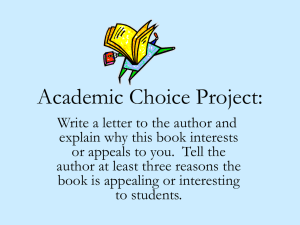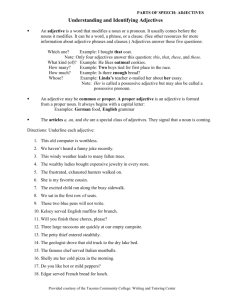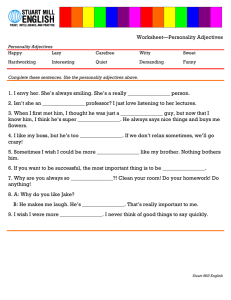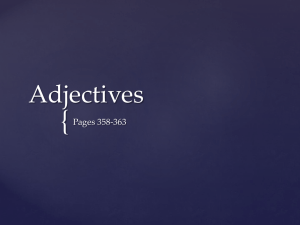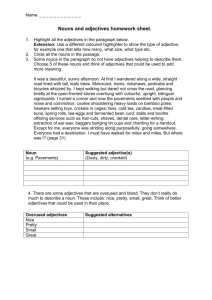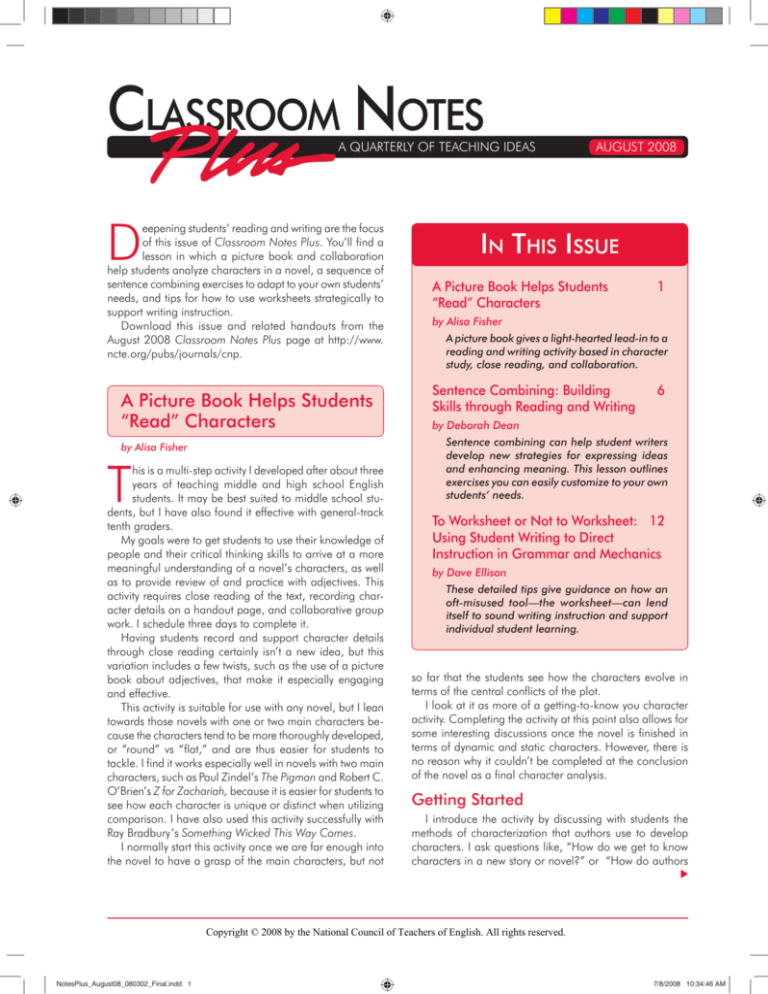
CLASSROOM NOTES
AUGUST 2008
CLASSROOM NOTES PLUS
A QUARTERLY OF TEACHING IDEAS
D
eepening students’ reading and writing are the focus
of this issue of Classroom Notes Plus. You’ll find a
lesson in which a picture book and collaboration
help students analyze characters in a novel, a sequence of
sentence combining exercises to adapt to your own students’
needs, and tips for how to use worksheets strategically to
support writing instruction.
Download this issue and related handouts from the
August 2008 Classroom Notes Plus page at http://www.
ncte.org/pubs/journals/cnp.
A Picture Book Helps Students
“Read” Characters
by Alisa Fisher
T
AUGUST 2008
IN THIS ISSUE
A Picture Book Helps Students
“Read” Characters
1
by Alisa Fisher
A picture book gives a light-hearted lead-in to a
reading and writing activity based in character
study, close reading, and collaboration.
Sentence Combining: Building
Skills through Reading and Writing
6
by Deborah Dean
Sentence combining can help student writers
develop new strategies for expressing ideas
and enhancing meaning. This lesson outlines
exercises you can easily customize to your own
students’ needs.
To Worksheet or Not to Worksheet: 12
Using Student Writing to Direct
Instruction in Grammar and Mechanics
by Dave Ellison
These detailed tips give guidance on how an
oft-misused tool—the worksheet—can lend
itself to sound writing instruction and support
individual student learning.
so far that the students see how the characters evolve in
terms of the central conflicts of the plot.
I look at it as more of a getting-to-know you character
activity. Completing the activity at this point also allows for
some interesting discussions once the novel is finished in
terms of dynamic and static characters. However, there is
no reason why it couldn’t be completed at the conclusion
of the novel as a final character analysis.
Getting Started
I introduce the activity by discussing with students the
methods of characterization that authors use to develop
characters. I ask questions like, “How do we get to know
characters in a new story or novel?” or “How do authors
▼
his is a multi-step activity I developed after about three
years of teaching middle and high school English
students. It may be best suited to middle school students, but I have also found it effective with general-track
tenth graders.
My goals were to get students to use their knowledge of
people and their critical thinking skills to arrive at a more
meaningful understanding of a novel’s characters, as well
as to provide review of and practice with adjectives. This
activity requires close reading of the text, recording character details on a handout page, and collaborative group
work. I schedule three days to complete it.
Having students record and support character details
through close reading certainly isn’t a new idea, but this
variation includes a few twists, such as the use of a picture
book about adjectives, that make it especially engaging
and effective.
This activity is suitable for use with any novel, but I lean
towards those novels with one or two main characters because the characters tend to be more thoroughly developed,
or “round” vs “flat,” and are thus easier for students to
tackle. I find it works especially well in novels with two main
characters, such as Paul Zindel’s The Pigman and Robert C.
O’Brien’s Z for Zachariah, because it is easier for students to
see how each character is unique or distinct when utilizing
comparison. I have also used this activity successfully with
Ray Bradbury’s Something Wicked This Way Comes.
I normally start this activity once we are far enough into
the novel to have a grasp of the main characters, but not
1
Copyright © 2008 by the National Council of Teachers of English. All rights reserved.
NotesPlus_August08_080302_Final.indd 1
7/8/2008 10:34:46 AM
2
CLASSROOM NOTES PLUS
help us get acquainted with their characters?” I use leading
questions like these to get students thinking about details
of characters’ physical appearance, speech, thoughts and
feelings, actions, and the opinions other characters have
about them.
I also invite students to consider books and stories they
have read, especially recently, because it’s often easier for
them to generate an answer if they have a specific character
in mind. Typical student responses might include:
Ponyboy in The Outsiders looks a certain way. His slicked
back hair, jeans, and leather jacket make him a part of
the Greasers.
In Roll of Thunder, Hear My Cry, Cassie has no problem
speaking her mind to others.
If students are having trouble coming up with ideas, I
might read aloud a sentence with character detail from a
recent novel we’ve read, and ask students what they learn
or infer about the character from this passage.
We then talk about how a reader can take the author’s
“clues” about characters in order to come to an understanding about them, and I use this as an opportunity to
bring up the role of adjectives. I mention that adjectives are
valuable words for writers, since they help define characters
and scenes and make them come alive for the reader. This
serves as a handy lead-in to the next step.
Reviewing Adjectives with a Picture
Book
At this point I tell students I’m going to share a spectacularly illustrated nonfiction book about adjectives, titled Many
Luscious Lollipops, and written by Ruth Heller.
Depending on the grade level and language ability of
the class, some students may feel it’s a little silly, but it’s
CLASSROOM NOTES
Project Coordinator
Felice Kaufmann
Editorial Assistant
Shellie Elson
Design
Joellen Bryant
Layout
Tom Jaczak
Copyright © 2008 by the National Council of Teachers of English.
Volume 26, Number 1 (August 2008)
It is the policy of NCTE in its journals and other publications to provide a forum for the open discussion of ideas concerning the content
and the teaching of English and the language arts. Publicity accorded
to any particular point of view does not imply endorsement by the
Executive Committee, the Board of Directors, or the membership at
large, except in announcements of policy, where such endorsement is
clearly specified.
NotesPlus_August08_080302_Final.indd 2
AUGUST 2008
a light-hearted way to explore the topic, and is especially
helpful to any students who are still learning to recognize
and use adjectives.
Besides being a great adjective review, Many Luscious
Lollipops offers engaging, vivid pictures, and uses a rhythm
and rhyme scheme that lend itself to a lively delivery, whether
read aloud by the teacher or by student volunteers. Here‘s
a sample stanza from page 2:
“An adjective’s terrific
when you want to be specific.
It easily identifies by number, color, or by size.
TWELVE LARGE, BLUE, GORGEOUS butterflies.“
Reprinted with permission from Many Luscious Lollipops by Ruth Heller.
(Scholastic, Inc., 1989). Used by permission of Grosset and Dunlap,
a division of Penguin Books for Young Readers. Copyright ©1989
by Ruth Heller.
After we finish Many Luscious Lollipops, I prompt students
to talk about their reactions, by asking questions like “What
did you like best?,” “Which page was your favorite?,”
“What are some of the categories of adjectives you learned
about?,” and “How could this book help you improve your
own writing?”
Character Analysis: A Collaborative
Exercise
Next I tell students that they are going to put their knowledge of characters and adjectives to work with a cooperative
group activity, based on the book we’ve started reading,
The Pigman.
I give each student a two-sided handout of a graphic
organizer like the sample shown on page 3. (Download this
handout page from the August 2008 Classroom Notes Plus
web page at www.ncte.org/pubs/journals/cnp/issues) Then
I give students the guidelines for their assignment.
CLASSROOM NOTES PLUS (ISSN 1526-5641) is published four times a
year, in January, April, August, and October, by the National Council
of Teachers of English, 1111 W. Kenyon Road, Urbana, IL 618011096. Annual membership in NCTE is $40 for individuals, and a
member subscription to CNP is $20.00. Single copy: $10 (member
price $5). Remittances should be made payable to NCTE by credit
card, or by check, money order, or bank draft in U.S. currency. Orders
can also be placed toll-free at (877) 369-6283 or online at www.ncte.
org. Communications regarding orders, subscriptions, single copies,
or change of address should be addressed to CLASSROOM NOTES PLUS,
1111 W. Kenyon Road, Urbana, IL 61801-1096. Communications
regarding permission to reprint should be addressed to Permissions,
NCTE, 1111 W. Kenyon Road, Urbana, IL 61801-1096. Communications regarding advertising should be addressed to Carrie Stewart,
NCTE,1111 W. Kenyon Road, Urbana, IL 61801-1096. POSTMASTER: Send address changes to CLASSROOM NOTES PLUS, 1111 W. Kenyon
Road, Urbana, IL 61801-1096. Periodical postage paid at Urbana,
Illinois, and at additional mailing offices.
7/8/2008 10:34:47 AM
AUGUST 2008
CLASSROOM NOTES PLUS
3
Handout on ________________ (Character Name)
passage:
word:
passage:
word:
word:
passage:
word:
Download this handout page from the August 2008 Classroom Notes Plus web page at
http://www.ncte.org/pubs/journals/cnp/issues
NotesPlus_August08_080302_Final.indd 3
▼
passage:
7/8/2008 10:34:47 AM
4
CLASSROOM NOTES PLUS
Student Assignment
In a few minutes I will assign you into small groups of
3-4 students. Your job is going to be to think of four distinct
adjectives to describe John and four distinct adjectives to
describe Lorraine, as a group, and to record these words
on your graphic organizer. Write the character’s name in
the center of the circle.
Each student is to fill out a copy of the two-sided
handout page, one side for each character, even though
you are coming up with the answers together.
You should think about what you have learned about
the characters so far, considering their appearance,
actions, thoughts and feelings, speech, what others
say about them, and any other information you feel is
relevant. Jot down possible adjectives as they come to
you, consult the thesaurus and dictionary if you like, and
confer with your group about your ideas.
After your group agrees on the first adjective, write
down that word on the line closest to the center circle, and
then look through chapters 1-5 of the text for a quote to
support the chosen word. Once your group has agreed
on the quote, write that down in the rest of the space.
There are four quadrants on the graphic organizer,
one for each adjective and book passage.
The point of requesting “distinct” adjectives is so students
will need to consider a variety of characteristics for each
character, and won’t simply choose multiple synonyms for
the same characteristic.
When students begin working on identifying the adjectives that describe their character(s), I encourage them to
talk and share ideas within their groups. The main point
of having them work in cooperative groups is so they can
bounce ideas off each other and expand their thinking.
I also circulate around the room to help and consult. A
common problem is that a student will think of a word that
is not an adjective, as in the example “John is a rebel.” In
this case I might respond, “Yes, that’s true, but rebel is a
noun. Let’s see if we can find an adjective that carries the
same idea.”
I might also review the part of Many Luscious Lollipops
which talks about creating an adjective by adding a suffix.
From this a student will be able to figure out the adjective
form of “rebel” is “rebellious.”
Finding Support in the Text
Next I might say something like, “Now, can you find a
passage from Chapters 1-5 (of The Pigman) that would
show that John is rebellious?”
Typically someone in the group will say, “What about the
time he let off bombs in the boys’ bathroom at school?”
NotesPlus_August08_080302_Final.indd 4
AUGUST 2008
and the students will begin paging through their books,
searching for the example.
Typically, even if students haven’t completed the book,
at least one student can recall the location of the passage
or get close enough that a few minutes of skimming yields
the appropriate passages. When students get stuck they can
describe the passage they’re thinking of and I can usually
help them find it. Referring back to familiar text is beneficial,
because it helps students absorb the material, and in the
process they often make a new insight into a character or
another aspect of the novel.
Next, students record the adjective and corresponding
passage (or as much as will fit, plus an ellipsis) in the graphic
organizer. I also instruct students to record the page number
of the passage for reference.
Once students are finished, each group shares their
words, along with the passages that support them, and I
make a master list on the overhead.
Here’s an example of the master list of adjectives for
John Conlan that we produced:
angry, rebellious, indignant, immature, smart-mouthed,
cocky, spiteful, creative, sullen, critical, obnoxious, handsome, cavalier, clever, observant, depressed, sarcastic,
mischievous
Students enjoy the process of sharing their words as a
class and justifying them with text references. As we proceed,
I ask the class if there are any words that just don’t fit, and if
we agree that there are, then I cross those words out. When
there is more than one character then we repeat this step.
Here are some sample pairings of words and passages
produced in my class:
Character: John Conlan from The Pigman
Word: mischievious;
Passage: “But on Wednesdays when I knew there was
going to be a substitute teaching one of the classes, I’d
pass the word at lunch and all the kids in that class would
buy these scrawny apples. Then we’d take them to class
and wait for the right moment-like when the substitute
was writing on the blackboard. . . . Then I gave this
phony sneeze that meant to hold them down near the
floor. When I whistled, that was the signal to roll ‘em.
Did you ever hear a herd of buffalo stampeding?” p. 2
Character: John Conlan
Word: cocky;
Passage: “Like Lorraine told you, I really am very handsome and do have fabulous eyes. But that doesn’t get
me much, except perhaps with Miss King, this English
teacher I’m going to tell you about. I think she really
goes for me the way she always laughs a little when she
talks to me and says I’m such a card.” p. 14
7/8/2008 10:34:47 AM
AUGUST 2008
CLASSROOM NOTES PLUS
5
The prompt is “Which
three adjectives are most
accurate in describing
John and why?” and I
ask students to write one
paragraph of four to six
sentences.
The purpose of this
reflection is to have students analyze the list
more deeply and to bring
closure to the activity.
Here’s a sample journal entry:
Sample Quadrant for The Pigman
Character: John Conlan
Word: spiteful
Passage: “Now it was just the way I said yeah that set
him off, and that night when he got home, he just put
the lock on the phone and didn’t say a word. But I’m
used to it. Bore and I have been having a lot of trouble
communicating lately as it is, and sometimes I go a little
crazy when I feel I’m being picked on or not being trusted.
That’s why I finally put airplane glue in the keyhole of
the lock so nobody could use the telephone, key or no
key.” p. 16
“I think John is cocky,
rebellious, and clever,
because almost from the
very start of the book John
is getting into some type
of trouble.
He has problems with
just about every adult he
comes into contact with and he does not deal with criticism well. He seems like the type of person who always
thinks the other person is wrong. He also seems smart
because when he plans to do something, like the bathroom bombs or apple roll, it’s usually extra well-planned
out or unusual, so this is why I would say he’s clever.”
Journal Entry
This activity takes approximately three days to complete,
and is open to modification—for instance, to spend more
time on adjective use or on discussion of the reading. It
lends itself to end-of-the-book discussions because you
can return to the list when students are done reading and
talk about whether the adjectives still fit the characters. You
can also discuss static and dynamic characters—review the
terms briefly, and then ask students which characters they
see change or grow throughout the novel, and how they
change. Do students see changes in minor characters like
Norton and Lorraine’s mother?
A variety of discussion and writing topics are possible
based on the adjective exercise, the completed character
handout sheet, and the journal entry assignment.
Overall, I consider this activity effective because it makes
students think, gives them a chance to work together and
bounce their ideas off one another, and promotes closer
reading of the text.
Finally, after students examine our master list, I assign
a journal entry either as in-class writing or as homework.
Alisa Fisher, St. Bernard-Elmwood Place High School,
Cincinnati, Ohio
During this step where we share adjectives and talk about
the characters, I can tell from students’ comments that they
are developing a more analytical stance toward the characters as a result. Here’s a representative exchange:
Student #1: “I don’t think ‘angry’ fits John. He just isn’t
an angry type of person. He may act out at school or with
his parents, but that’s just his rebellious way of responding to the adult world of rules. John is free spirited and
doesn’t want to conform.”
Student #2: “You’re right, when John acts like a smart
aleck it’s more in defiance of adults and their rules than
it is out of hatred.”
NotesPlus_August08_080302_Final.indd 5
7/8/2008 10:34:47 AM



